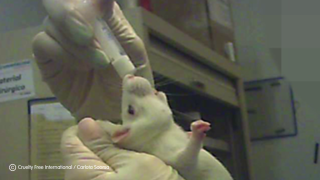Prevention and human studies hold the key to tackling diabetes epidemic
Today is World Diabetes Day, which aims to increase the awareness of the global impact of diabetes and encourage healthy eating to prevent the disease from developing.
Sadly, scientists have used animals in diabetes research for over a century and yet the number of people with the disease continues to rise at an alarming rate. It is now one of the most common public health problems in the world, affecting an estimated 347 million people worldwide.1
Mice, rats, rabbits, cats, dogs, sheep and monkeys are all used in diabetes research.
To artificially induce diabetes, animals are often injected with toxic chemicals to damage the insulin-producing cells in their pancreas, or their pancreas is surgically removed. This is extremely crude and does not reflect the situation in humans where the disease develops over a long period of time and is caused by insulin resistance.
Animals are also often forced to consume a high fat ‘Western-style diet’ in order to induce obesity and diabetes. These experiments are highly unreliable as the percentage of animals who actually progress to full-on diabetes is small. Even the animals who do develop diabetes do not develop the complications associated with the disease in humans.
The use of genetically modified (GM) mice to target genes associated with diabetes has also become ‘popular’. However, the disease that is created in GM mice is different to diabetes in humans and to rely on these experiments is potentially dangerous.
Per-Olof Beggren, professor at the Diabetes Research Institute said, “Human pancreatic islets (insulin-producing cells) have a unique architecture and work differently than rodent islets. We can no longer rely on studies in mice and rats. It is now imperative that we focus on human islets. At the end of the day, that is the only way to understand how they function”.2
Despite the ongoing use of animals in cruel experiments, there is still no cure for diabetes.
However, insulin therapy can be used to control symptoms by keeping blood sugar levels stable.
It is often stated that experiments on dogs were crucial to the discovery of insulin and this ‘fact’ is used a justification for all future animal experiments. But like other medical breakthrough stories, the important clues actually came from clinical investigation of patients and autopsy reports. Humane in vitro studies were then used to isolate insulin, not animal experiments.3
Instead of continuing to subject animals to such outdated and pointless experiments, diabetes research should focus on ethical studies in humans and prevention.
Sources:
- 10 facts about diabetes. World Health Organisation: http://www.who.int/features/factfiles/diabetes/en/
- Researchers find striking differences between human and animal insulin-producing islet cells. (2006). Diabetes Research Institute Foundation: http://www.diabetesresearch.org/page.aspx?pid=409
- M. Bliss. The Discovery of Insulin. Chicago











